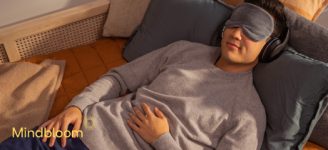
At Home Ketamine and Mental Wellness
DISCLOSURE: This is a PAID PLACEMENT and contains AFFILIATE LINKS. The Klubb was compensated for this post and receives a commission when a purchase is made using one of the Mindbloom affiliate links within the article. We are not medical professionals. Consult a medical professional. This article contains opinions of 3rd party independent contributors. Opinions expressed by these contributors are their own.
According to the National Alliance on Mental Illness, approximately 1 and 5 adults and 1 in 6 youth in the United States experience mental illness every year. Historically, selective serotonin reuptake inhibitors, or SSRIs, have been the chosen class of medication to treat said mental illness. However, a new drug is making headlines for its role in treating mental illness.
Ketamine, a drug commonly used as an anesthetic, is gaining traction in the world of mental health for its role in treating mental illnesses like depressive disorders and suicidal ideation. In particular, a recent study from the Journal of Affective Disorders has found that “at-home, ketamine is a safe and effective treatment for moderate to severe anxiety and depression.”
What is Ketamine?
Ketamine is a dissociative anesthetic with some hallucinogenic effects. It’s referred to as “disassociative” because it helps patients detach from their physical environment and mental or physical pain.
Regarding mental illnesses like anxiety, depression, and other psychiatric conditions, ketamine has been found to be relatively fast-acting. Its effectiveness is attributed to its effects on the N-methyl-D-aspartate (NMDA) receptor. The NMDA receptor is one of four receptors of glutamate, the primary excitatory neurotransmitter in the human brain.
In the United States, the FDA has approved ketamine for anesthesia and pain management. Additionally, the proliferation of the off-label usage of ketamine to treat certain mental illnesses in an at-home setting is on the rise.
Sources:
At-Home Ketamine-Assisted Therapy (KAT)
KAT is a new form of treatment that combines the remotely monitored usage of sublingual ketamine (i.e., ketamine dissolved under the tongue) with telehealth doctor visits. To get a better understanding of KAT, researchers devised a research project that included over 1,200 adults who were all diagnosed with severe anxiety, moderate to severe depression, or both. The new combined strategy showed promising results.
Important findings from the study
- Almost 89% of the participants saw improvements in their anxiety or depression symptoms either immediately or after the first couple of sessions.
- 63% of the participants had a 50% reduction in their symptoms of anxiety or depression, including suicidal thoughts or ideas.
- Side effects from using ketamine were reported by under 5% of participants, and only 4 participants of the original 1,200 left the study due to adverse events.
Overall, the study demonstrated that KAT can be super effective for certain patients and have an extremely low rate of negative side effects. When compared to SSRIs or antidepressant drugs like Prozac, Zoloft, and Celexa, the results are particularly positive.
However, researchers conducting the study have labeled it only as a starting point. They are calling for more research to be done in the field of KAT. In particular, a randomized placebo-controlled clinical trial is required to truly understand the positive or negative effects KAT may have.
How Does KAT Work?
Every company within the at-home ketamine therapy market operates differently. However, there are standout characteristics of the process that are well-defined. At-home ketamine therapy combines the self-administration of prescribed sublingual ketamine tablets with telehealth therapy sessions.
Before the ketamine medication is delivered to your home, an online virtual assessment is carried out by a mental health professional. This is largely aimed at understanding your mental and physical health, and therapy goals. It’s also for the provider to assess whether or not you are a good fit for the treatment.
After you’ve met with a clinician, been approved for treatment, and received a ketamine prescription, the medication is delivered to your home. At this point, you can begin your at-home treatment program. Oftentimes, treatments are carried out with the guidance of a mental health representative or guide. In addition, most KAT providers recommend you have a nearby peer treatment monitor or trusted individual over the age of 18 who can help if necessary.
Again, every treatment program will vary. However, most of the time, after your first treatment, a clinician schedules a follow-up consultation to assess your experience and adjust your dosing. From there, you are free to continue your at-home treatment with the guidance of medical-health professionals. As you move through your sessions, most KAT providers supply additional resources to accompany your treatment so you can get the most out of your experience.
At-home Ketamine Therapy is Expanding
When compared to other forms of ketamine therapy, at-home KAT has one major advantage, and because of it, it’s expanding. The advantage? Equitable access to care.
In the past, ketamine therapy was administered either intravenously (i.e., into the veins) or intramuscularly (i.e., in the muscles). This type of therapy requires medical professionals and patients to be in the same place.
On the other hand, KAT breaks down the obstacle of needing to see your doctor in person to receive treatment. Therefore, the ability to remotely monitor the administration of ketamine and combine its usage with virtual telehealth sessions greatly expands the therapy’s potential impact. This is a particularly standout advantage for the most affected patients with crippling anxiety or depression or those with insurmountable pain points related to traditional in-person therapeutic treatment.
How Much Does KAT Cost?
According to the referenced study above, researchers report that sublingual ketamine costs between $200 and $250 per dose. This may sound expensive, and for many, it is. However, when compared to other modes of ketamine administration like intravenous or intramuscular, it’s cheaper.
Regarding the costs, one current fallback of KAT is that most traditional health insurance plans do not cover the bill. This means that the brunt of the financial burden for therapy falls on the patient.
The cost burden is another reason why researchers and proponents of KAT want there to be more rigorous clinical trials of the treatment. With more legitimate data and widespread knowledge of the potential benefits of KAT, insurance companies are more likely to begin covering the costs of the ketamine dose along with the costs of the telehealth session, greatly reducing the financial barrier to treatment.
Potential Shortcomings of the Recent Proliferation of KAT
KAT may not be appropriate for everyone, especially those with a history of substance abuse.
In addition, The COVID-19 pandemic, along with technological advances, has fostered an uptick in virtual and telehealth services. KAT is uniquely paired with the advances in technology and access to virtual therapy. Unfortunately, not all providers of at-home treatments may have qualified medical personnel or staff onboard. Therefore, in some cases, the source of the psychiatric guidance may be lacking in terms of experience and expertise.
Final Thoughts About KAT
At-home ketamine therapy is not only gaining popularity amongst lay people and those suffering from mental illness. It’s also beginning to gain some traction in the academic world. If the preliminary investigations of at-home therapy with sublingual ketamine continue to garner positive results, it could lay the foundation for more advanced and long-term ketamine-related medical research.
In the meantime, it’s critical to do your own research and consult your primary care physician and mental health clinician. Then, should you choose to participate in at-home ketamine therapy to treat your mental illness, plenty of due diligence is required to ensure that you select a KAT provider with legitimate expertise in the subject and breadth of positive testimonials.
Even then, remember– KAT is not for everyone and may not be the solution to your mental health struggles. In whatever stage or type of treatment you’re in, we wish you the very best.






